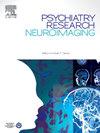青少年物质使用障碍及其未受影响的兄弟姐妹的神经解剖学模式
IF 2.1
4区 医学
Q3 CLINICAL NEUROLOGY
引用次数: 0
摘要
关于青少年物质使用障碍(SUD)的潜在神经生物学机制知之甚少。我们的目的是检查患有SUD的青少年及其未受影响的生物兄弟姐妹(SIB)的脑形态学,相对于典型发展对照(TDC),以确定可能与SUD家族风险相关的改变。结构磁共振成像分析包括20例青少年SUD、20例SIB和18例TDC。与TDC相比,青少年SUD主要表现为右侧前额叶皮层厚度较低。重要的是,与TDC相比,SIB组右侧额下叶皮质(IFC)皮层厚度较低,扣带回峡部和楔前叶皮质表面积较大。我们没有发现两组之间皮层下体积或形状的显著差异。总之,我们的研究结果表明,右侧IFC皮层厚度较低可能是SUD的候选内表型。此外,扣带回峡部和楔前叶皮质表面积增大可能反映了代偿或保护作用。本文章由计算机程序翻译,如有差异,请以英文原文为准。
Neuroanatomical patterns in adolescents with substance use disorder and their unaffected siblings
Little is known about the underlying neurobiological mechanisms in adolescents with substance use disorder (SUD). We aimed to examine brain morphology in adolescents with SUD and their unaffected biological siblings (SIB), relative to typically-developing controls (TDC) to identify alterations that may be associated with the familial risk for SUD. Structural magnetic resonance imaging analysis included 20 adolescents with SUD, 20 SIB, and 18 TDC. Adolescents with SUD showed lower cortical thickness mainly in the right prefrontal cortex compared to TDC. Importantly, the SIB group also showed lower cortical thickness in the right inferior frontal cortex (IFC) and larger cortical surface area in the isthmus of the cingulate gyrus and precuneus compared to TDC. We did not detect significant differences in subcortical volume or shape between groups. In conclusion, our results suggest that lower cortical thickness in the right IFC might be a candidate endophenotype for SUD. In addition, enlarged cortical surface area in the isthmus of the cingulate gyrus and precuneus might reflect compensatory or protective effects.
求助全文
通过发布文献求助,成功后即可免费获取论文全文。
去求助
来源期刊
CiteScore
3.80
自引率
0.00%
发文量
86
审稿时长
22.5 weeks
期刊介绍:
The Neuroimaging section of Psychiatry Research publishes manuscripts on positron emission tomography, magnetic resonance imaging, computerized electroencephalographic topography, regional cerebral blood flow, computed tomography, magnetoencephalography, autoradiography, post-mortem regional analyses, and other imaging techniques. Reports concerning results in psychiatric disorders, dementias, and the effects of behaviorial tasks and pharmacological treatments are featured. We also invite manuscripts on the methods of obtaining images and computer processing of the images themselves. Selected case reports are also published.

 求助内容:
求助内容: 应助结果提醒方式:
应助结果提醒方式:


